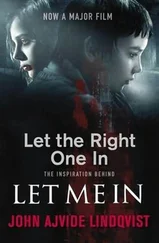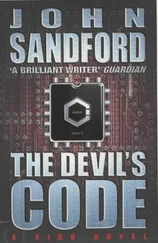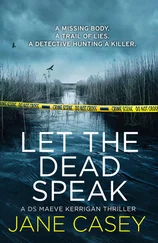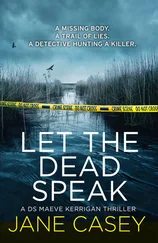“All of which makes sense,” interjected Trout. “It reinforces everything we’ve been saying about the case from the very beginning.”
Gurney ignored the interruption, remaining focused on Holdenfield. “How angry would you say he was?”
“What?”
“How angry was the man who wrote that?”
The question seemed to surprise her. She picked up her copy and reread it. “Well… he employs frequent emotional language and images- ‘blood… evil… stain… guilt… punishment… death… poison… monsters’ -expressing a kind of biblical rage.”
“Is it rage we’re seeing in that document. Or a depiction of rage?”
There was a tiny twitch at the corner of her mouth. “The distinction being…?”
“I’m wondering if this is a furious man expressing his fury or a calm man writing what he imagines a furious man would write under these circumstances.”
Trout broke in again. “What’s the point of this?”
“It’s pretty basic,” said Gurney. “I’m wondering if Dr. Holdenfield, a very insightful psychotherapist, feels that the writer of this message was expressing an authentic emotion of his own, or was he, in a way, putting words in the mouth of a fictional character he’d invented-the so-called Good Shepherd.”
Trout looked at Bullard. “Lieutenant, we can’t spend the whole day on this kind of eccentric theorizing. This is your meeting. I’d urge you to exert some control over the agenda.”
Gurney continued to hold the psychologist’s gaze. “Simple question, Rebecca. What do you think?”
She took a long time before replying. “I’m not sure.”
Gurney sensed, finally, some honesty in Holdenfield’s eyes and in her answer.
Bullard looked troubled. “David, a couple of minutes ago, you used the phrase ‘purely practical’ in relation to the Good Shepherd. What kind of purely practical motive could prompt a killer to choose six victims whose main connection with one another is that they were driving extravagant cars?”
“Extravagant black Mercedes cars,” corrected Gurney, more to himself than to her- The Man with the Black Umbrella coming once again to mind. Referring to the plot of a movie during the discussion of a real crime was risky, especially in unfriendly company, but Gurney decided to go ahead. He recounted how the snipers were stymied in their pursuit of the man with the umbrella when he was immersed in a crowd of people with similar umbrellas.
“What the hell’s the connection between that story and what we’re here to talk about?” It was Daker’s first comment at the table.
Gurney smiled. “I don’t know. I just have the feeling that there is one. I was hoping someone in the room might be perceptive enough to see it.”
Trout rolled his eyes.
Bullard picked up the e-mail in which Gurney had listed his questions about the murders. Her eyes stopped halfway down the page, and she read aloud. “ ‘Were they all equally important?’ ” She looked around the table. “That strikes me as an interesting question in the context of the umbrella story.”
“I don’t see the relevance,” said Daker.
Bullard’s eyes were blinking again, as though clicking off possibilities. “Suppose not all the victims were primary targets.”
“And the ones that weren’t-what were they? Mistakes? ” Trout’s expression was incredulous.
Gurney had already explored that avenue with Hardwick, and it had led to scenarios too unlikely to take seriously. “Not mistakes,” said Gurney. “But secondary, in some way.”
“Secondary?” repeated Daker. “What the hell does that mean?”
“I don’t know yet. It’s still just a question.”
Trout let his hands fall on the table with a bang. “I’ll only say this once. There comes a time in every investigation when we have to stop questioning the basics and concentrate on the pursuit of the perpetrator.”
“The problem here,” responded Gurney, “is that no serious questioning process ever got started.”
“Okay, okay,” said Bullard, raising her hands in a double “Stop” gesture. “I want to talk about action steps.”
She turned to Clegg, who was seated on her left. “Andy, give us a quick review of what’s happening.”
“Yes, ma’am.” He pulled a slim digital device out of his jacket pocket, tapped a few keys, and studied the screen. “Tech team has released the crime scene for general access. Physical evidence bagged, tagged, and entered in the system. Computer transported to computer forensics. Latent prints processed through IAFIS. Prelim ME report in hand. Autopsy report and full tox screens in seventy-two hours. Site and victim photos entered in the system, ditto incident report. CJIS report, third update, in the system. Status of door-to-doors: forty-eight completed, projected total sixty-six by end of day. Initial verbatims available, summaries to come. Based on two eyewitness observations of a Humvee or a Hummer-style vehicle in the vicinity, DMV is compiling ownership lists of all similar vehicles registered in central New York State.”
“Planned utilization of these lists being what?” asked Trout.
“A database against which we can run the names of any ID’d suspects, as they become available,” said Clegg.
Trout looked skeptical but said nothing more.
Gurney was uncomfortable with the fact that he already had the answer Clegg was chasing. Normally he favored maximum openness. But in this instance he feared that disclosure would only create a distraction and waste valuable time by diverting attention toward Clinter. And Clinter, after all, couldn’t be the Good Shepherd. He was peculiar. Possibly crazy. But evil? No, almost certainly not evil.
But he had another motive for silence, a less objective one. He didn’t want to appear too familiar with Clinter, too allied with him, too much on his wavelength. He didn’t want to be tarred by the association. Holdenfield had tossed that PTSD diagnosis into his lap during their lunch in Branville. At some point Max Clinter had also gotten a PTSD diagnosis. Gurney didn’t like the echo effect.
Clegg was winding up his report. “Tire-tread impressions made in the parking lot of Lakeside Collision are being processed, photos have been sent to vehicle forensics for original equipment and aftermarket matches. We got a decent side-to-side double impression. Crossing our fingers for a unique axle-width measurement.” He looked up from the screen of the device from which he’d been reading. “That’s as much as I’m aware of at the moment, Lieutenant.”
“Any promised callback time on the physical analysis of the Shepherd message-ink, paper, printer data, latents on the address form, inner envelope, et cetera?”
“They said they’d have a better idea within the next hour.”
Bullard nodded. “And the outgoing notifications?”
“Just starting that process. We have a preliminary list of family members in the background materials provided by Agent Daker. I believe Ms. Corazon is being contacted now for her own list of current phone numbers, per Mr. Gurney’s suggestion. Carly Madden in Public Information is helping to formulate an appropriate message.”
“She understands the communications objective -serious alert without panic -and the importance of getting it just right?”
“She’s been made aware of that.”
“Good. I’d like to see the draft before the live calls. Let’s move on that front ASAP.”
Gurney’s sense of the woman was firming up. She devoured stress like vitamins. Her job was probably her sole addiction. “ASAP” was almost certainly the way she wanted everything to happen. And adversaries should take care.
She looked around the table. “Questions?”
Читать дальше












